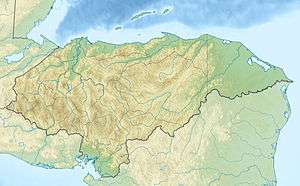Jeanette Kawas National Park
| Jeanette Kawas National Park | |
|---|---|
|
IUCN category II (national park) | |
|
Punta Sal peninsula beach near entrance to the Sendero Los Curumos | |
 Location of Jeanette Kawas in Honduras | |
| Location | Honduras |
| Coordinates | 15°49′06″N 87°22′03″W / 15.81833°N 87.36750°WCoordinates: 15°49′06″N 87°22′03″W / 15.81833°N 87.36750°W[1] |
| Area | 781.62 km2 (301.79 sq mi)[1] |
| Established |
4 November 1994[2] |
| Official name | Parque Nacional Jeanette Kawas |
| Designated | 28 March 1995 |
Jeanette Kawas National Park (Spanish: Parque Nacional Jeannette Kawas) is a national park located in the municipality of Tela, on the northern Caribbean coast of the Atlántida department of Honduras, established on 4 November 1994. The park covers an area of 781.62 square kilometres and has an altitude of 900 metres.[1] The park was created and is managed by the PROLANSATE foundation (protection of Lancetilla, Punta Sal and Texiguat).
History
The park was established on 4 November 1994, originally named Punta Sal National Park.[2] It was created and is managed by the PROLANSATE foundation (protection of Lancetilla, Punta Sal and Texiguat).
Its name was changed to Jeanette Kawas National Park in honor of Jeanette Kawas, an environmental activist and PROLANSATE president who was murdered on February 6, 1995 for her work trying to keep the palm plantations out of the park.
Jeanette Kawas National Park is part of the Ramsar Convention List of Wetlands of International Importance and was designated as such on March 28, 1995.
Geography
The park is located in the municipality of Tela, on the northern Caribbean coast of the Atlántida department of Honduras.[2] Located at 15º51'N 087º40'W between longitudes 87º29' and 87º52' west and latitudes 15º42' and 16º00'. It covers an area of 781.62 square kilometres and has an altitude of 900 metres.[1]
Ecosystems
The park is made up of varied marine, terrestrial and wetlands ecosystems with a large number of species. These ecosystems include beaches, tropical forests, inundated forests, mangrove forests, lagoons and rivers.
Species
Birds
- Keel-billed motmot
- Turquoise-browed motmot
- Green-breasted mountain-gem
- Lovely cotinga
- Resplendent quetzal
- Bushy-crested jay
- Blue-crowned chlorophonia
- Lesser ground-cuckoo
Mammals
Fishes
Reptiles
- American crocodile
- Sea turtle, such as green sea turtle, leatherback sea turtle, hawksbill turtle and the loggerhead turtle
- Green iguana
- Red-tailed boa
- Mexican burrowing snake
Arthropods
Plants
- Acalypha skutchii
- Cappatis truerchkhemii
- Columnea tuerckheimii
- Cordia truncatifolia
- Ormosia macrocalyx
- Phyllanthus elsiae
- Rinorea hummelii
- Salacia impressifolia
- Sida antillensis
- Sida troyana
See also
- La Tigra National park, Honduras first national park
References
- 1 2 3 4 "Honduras - Jeanette Kawas". United Nations Environment Programme. Retrieved 1 March 2010.
Further reading
- PARQUE NACIONAL PUNTA SAL Ramsar Information Sheet (pdf), Ramsar Sites Information Service (RSIS), 7 September 2011, 25 pages (in Spanish)
External links
- Birds of Honduras.com Robert Gallardo, n.d.
- profile of Jeanette Kawas National Park Carla Picinich, Department of Natural Resource Ecology and Management, Oklahoma State University, Stillwater, OK, n.d., retrieved 9 March 2016
- Interactive Map of Park INFOHN.COM (Info de Honduras S.A.) 2006
- Fundacion PROLANSATE web site (in Spanish) n.d.